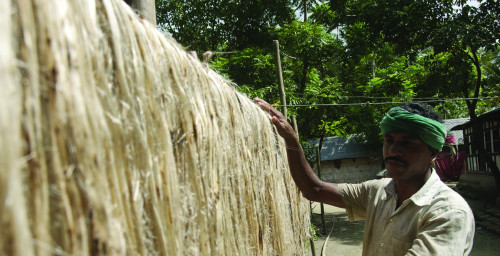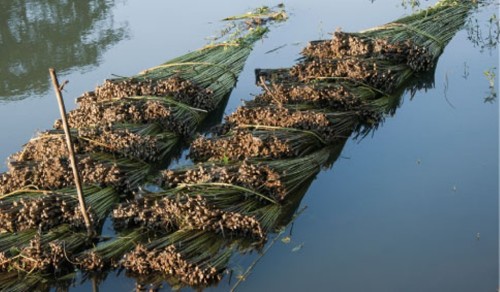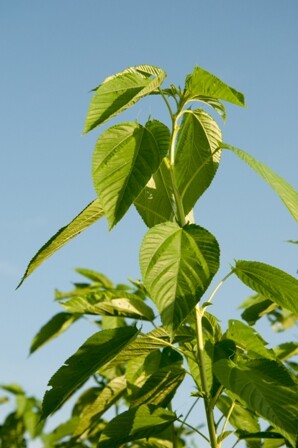
Jute is sown and harvested annually (the White Jute crop usually matures in July, and the Tossa crop slightly later). It grows best in monsoon climates, as the cultivation requires plentiful rainfall - essential not only for the good growth of the plant, but also to provide fresh water for retting (the plant is cut and immersed in clean pond-water or slow-running streams, to clean and soften the fibre and to enable it to be stripped from the stem). Too little rainfall can reduce the size of the crop and also affect the quality of the fibre, if there is insufficient water to remove impurities. Too much rain before the plants reach maturity may also reduce the size of the crop, if it becomes necessary to make an early harvest to avoid flooding damage.
Jute is mainly grown by small farmers in India and Bangladesh and traded through balers and stockists. The plant can grow to a height of more than three metres and fibre length of upto 2.5 metres. The lower part of the plant (known as the butt or cutting) can also be used for lower-quality purposes, or blended with longer fibre during spinning to reduce the cost of production. The stem of the plant can be burned as firewood, so very little is wasted.
Jute is also grown in South East Asia and in parts of China

The main specifications are:
BTA - BTR
BWA - BWR
BTCA/B & BWCA/B
The versatility of Jute - combined with a low cost base - makes it ideally suited to a variety of uses, ranging from:
Packaging - bags, sacks, wrapping material ie cotton packs and wool packs.
Geotextiles - landfill covering, embankment reinforcement, on roads and railways as it will biodegrade over a relatively short period of time.
Protection of rooting plants.
Hessian cloths of various types, including carpet backing material.
Braids and webbing.
Fine and coarse yarns.
Cable filler.
Industrial and domestic twine.
Specialist pulp and paper.
Recently being used as a filler with Abaca and Sisal in specialist pulps and paper production.

Jute is a member of the family of "soft" vegetable fibres, second only to cotton in the amount produced, and traditionally one of the cheapest of the natural fibres. It falls into the category of bast fibre (produced from the skin of the plant) and White Jute (Corchorus Capsularis) is known to have been cultivated in India more than four hundred years ago and to be spun into cloth by artisans, and it was also used in the production of ropes and twines.
Tossa Jute (Corchorus Olitorius) which is silkier and stronger than White Jute - has traditionally been grown around the area of the Ganges Delta, and was already in large-scale production two hundred years ago to allow export of raw fibre to a nascent Jute-spinning industry in Dundee when machinery used for Flax spinning was adapted to produce Jute yarns.
The principal use for these yarns was for cheap packaging - the term "Gunny bag" derives from a Hindi word - but as Jute spinning industries developed in countries across the world, the uses of Jute and Jute products expanded rapidly.
At one stage the future of Jute was threatened by the increase in use of synthetic fibres, but the environmental advantages of natural fibre and the closure of Jute spinning and weaving plants in many of the developed nations of the world, which resulted in the transfer of production of finished articles back to the point of origin of the fibre itself, have reduced the costs of production and enabled jute to maintain a stable level of consumption for an extended period.
Tossa Jute is known as the "Golden Fibre", from the lustrous appearance of the threads, although Tossa can range in colour from dark to reddish, depending upon the area of cultivation.
Bangladesh (formerly East Bengal until the Partition of India, and East Pakistan until independence), together with the Indian state of West Bengal, produces most of the world's Jute fibre.
There is also cultivation of Jute, or its allied fibre Kenaf (Hibiscus Cannabinus) - a coarser textured plant - in other Asian countries in particular Myanmar, Thailand, China.
New uses of Jute in the non-woven sectors have opened up fresh areas, to offset the decline in the production of more traditional articles. The Green Revolution is having a positive impact on the uses of Jute products and is likely to continue to do so.
We use cookies to give you the best online experience.
